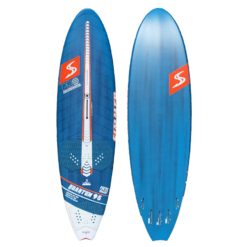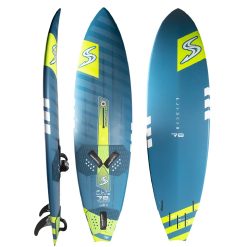The Flywave has earned a reputation as a top level high performance wave board for professionals and high level sailor at the best spots around the world, but it is equally well liked by intermediates and in less than perfect conditions. The legacy of the Flywave goes back to a rocker developed for Kai Katchadourian’s Peahi board. The winger-swallow based outline was developed together with Marc Paré, who is now back on the team. The constant curve rocker provides a lot of support under the mast foot which is what contributes to the enormous speed range of the Flywave. The wingered outline combined an ability to finish the bottom turn up in a vertical style with a good grip off the top.
In the G7 Flywave development we have for the first time in some years made a few shape updates. The first update concerns the tail length. As some will have noticed, the G6 Flywave 72 and 99 already sports a bit shorter, and hence wider looking tails, than the rest of the bunch. For the G7, the 78 and 84 gets the same shortened tail and to some degree also the 90. The shorter tail makes the board snappier in the bottom turn, allowing it to go even more vertical while also giving the board a better flow in the top turn. The 98 instead gets a tiny bit longer and narrower tail, to add early planing support for bigger guys and bigger sails.
We have also developed a new size, the Flywave 107 L. During our prototyping process the 107 has been getting rave reviews, both from heavy sailors and mid weight sailor wanting a real floaty board.
The second change incorporated in all sizes is a new bottom shape layout in the rear of the board. After several years of development our board designer, Ola Helenius, he has come up with a brand new Flywave design which uses the same central rockers as before, but has an increased and accelerated vee in the tail as well as a deepened tunnel concave inside the vee. Essentially, these two changes balances each other out. Both features increases the tail rocker along the rail and inside the concave respectively, but while the increased rail rocker gives the board a faster rail to rail feel and a slashier turn, the tunnel concave instead adds stability on rail.
The tail refinements in combination extends the range of different top turns the G7 Flywave performs in and give the rider even more options regarding what kind of lines he or she wants to draw on the wave. Essentially, the board now has a bit more projection and tracking when the sailor puts the power down, but also reacts quicker in transition between turns.
| Volume | 107L, 72L, 78L, 84L, 90L, 98L |
|---|
Related products
G7 Boards
G6 Boards
G7 Boards
G5 Boards
G6 Boards
G6 Boards
G6 Boards
G6 Boards
G6 Boards












